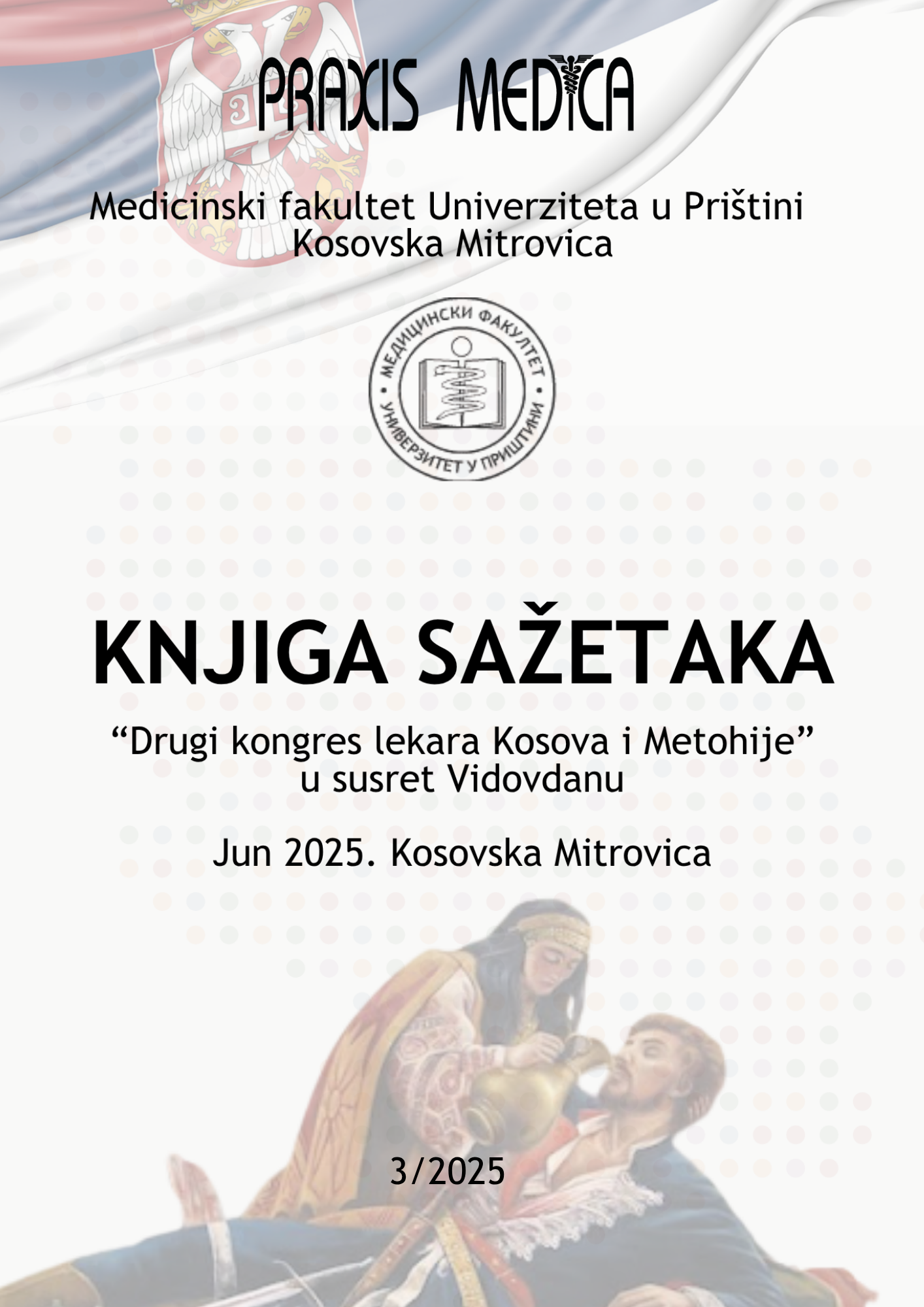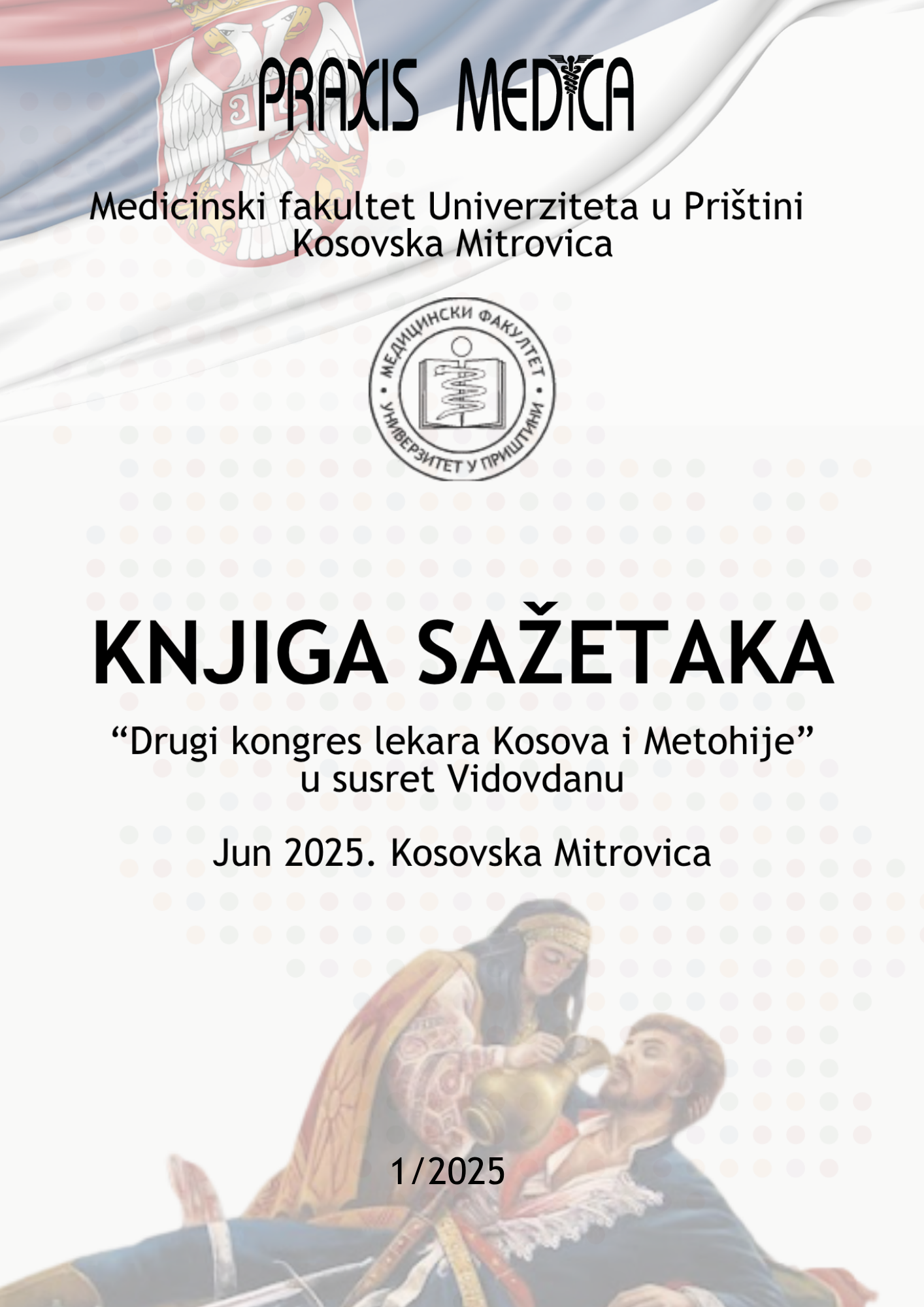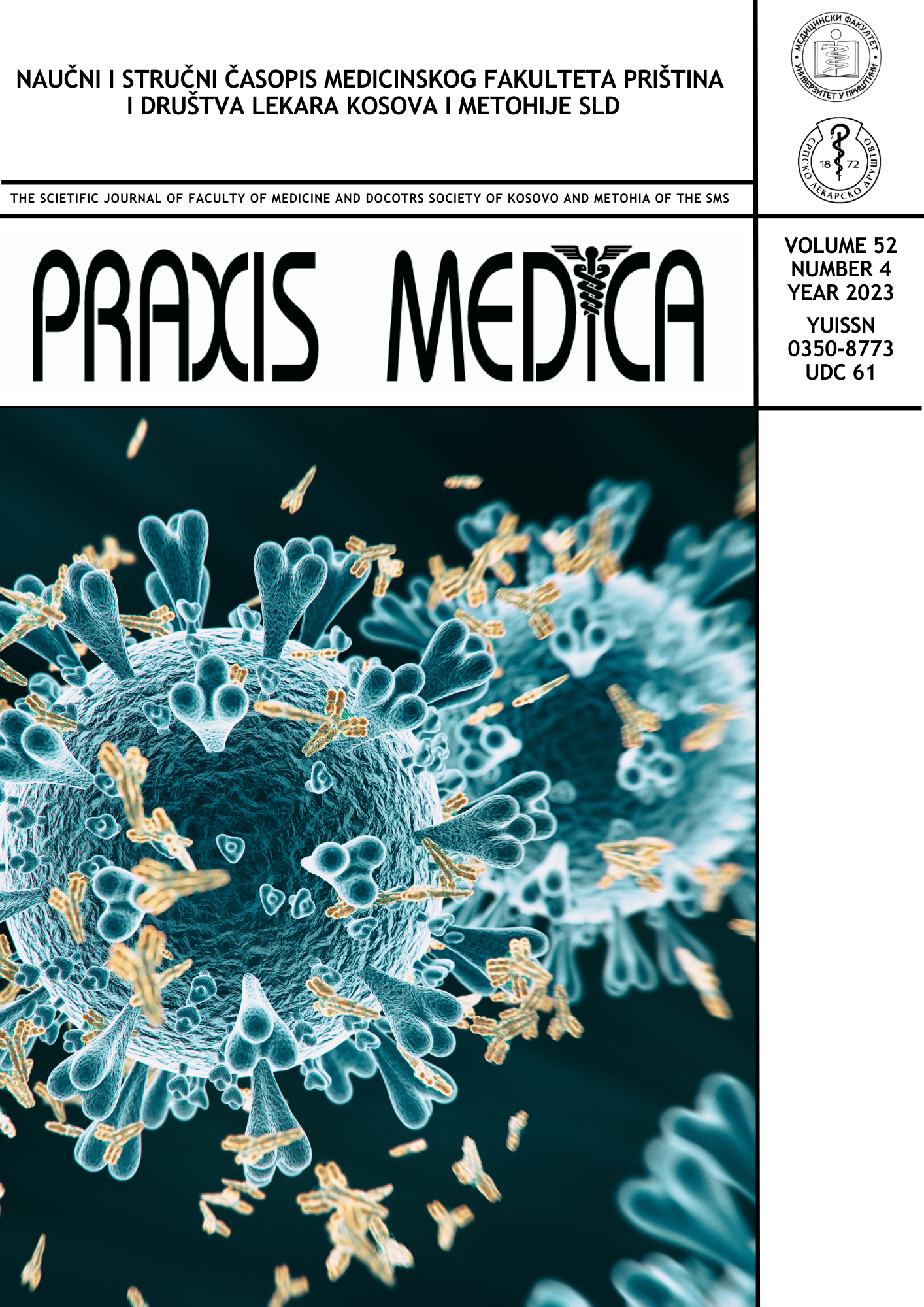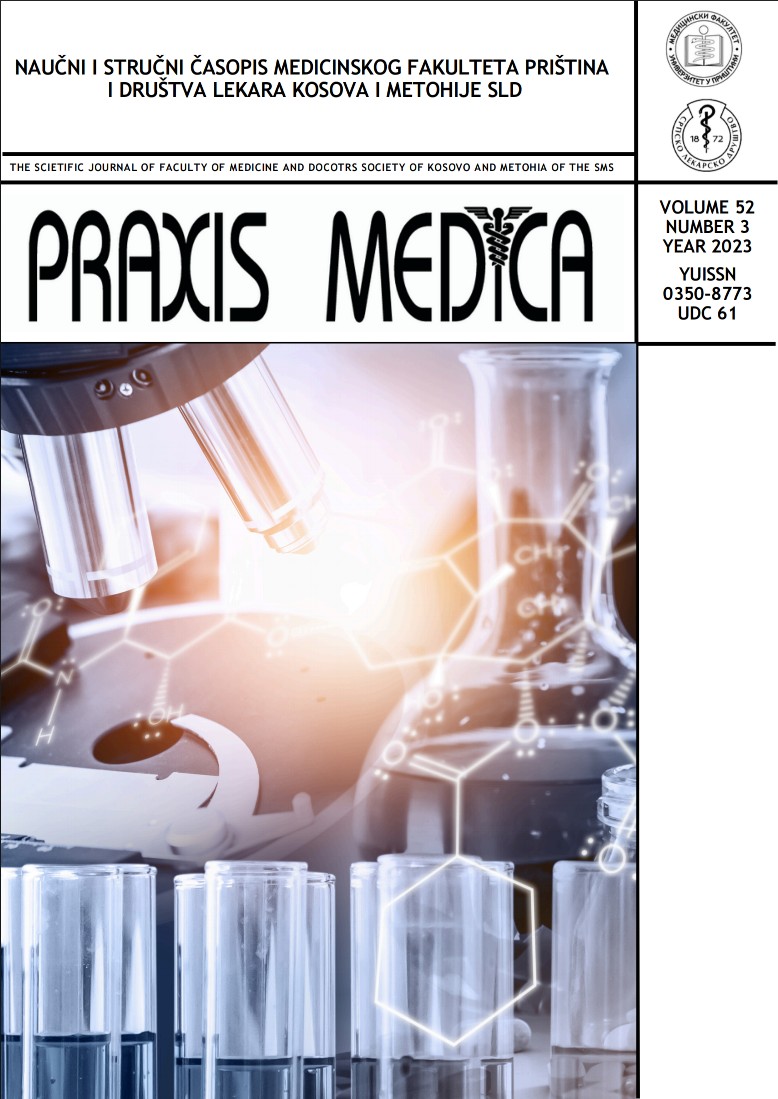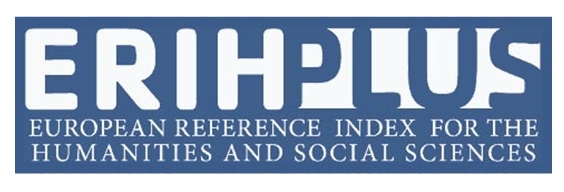Current issue
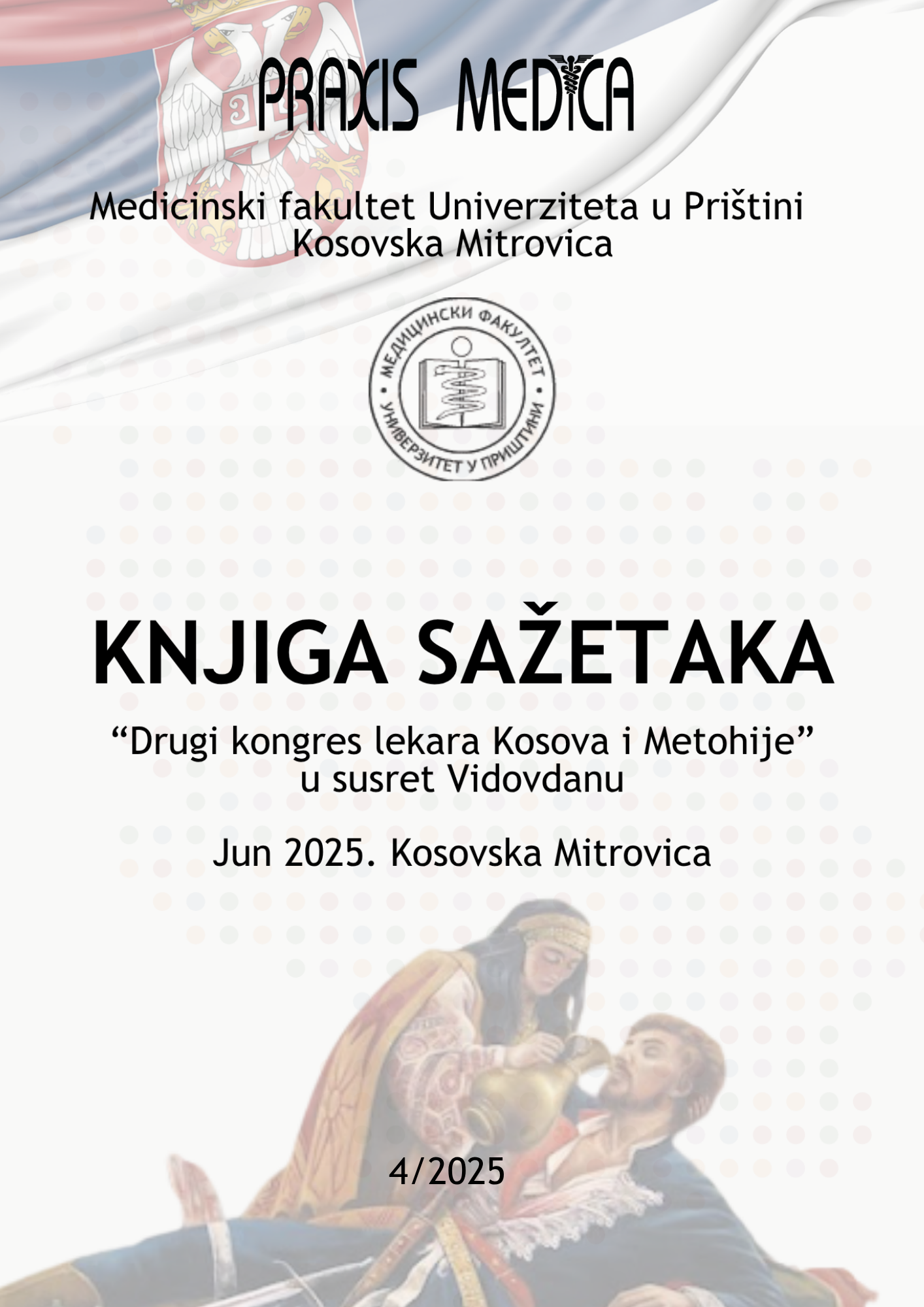
Volume 53, Issue 4, 2025
Online ISSN: 2560-3310
ISSN: 0350-8773
Volume 53 , Issue 4, (2025)
Published: 30.06.2025.
Open Access
All issues
Contents
01.12.2021.
Professional paper
Analysis of the characteristics of traffic trauma
Introduction: It is estimated that an average of 1,308 people die in traffic accidents in the world every day. Traffic accidents are caused by factors of the road, vehicles and the human factor, which occur alone or in combination with other factors in over 90% of cases. Material and methods: The retrospective systematic research included all cases of traffic trauma that were brought to the admission surgical outpatient clinic in the Clinical Hospital Center Kosovska Mitrovica in the period from January 2020 to December 2022. Results: In the observed period, 126 patients were registered. The age of the respondents differs statistically according to gender (p=0.030), and the highest frequency is male (81.8%) in the working population (18-59 years). The age of the subjects showed no statistical association with the types of injuries in traffic trauma (p=0.151). Friday and Saturday are the days with the highest risk (25.3% of injuries), and Sunday is the day with the least number of injuries (3.6%). The lowest number of injuries was recorded from January to May (n=12, 9.5%), and the highest was in the period August to October (n=54, 42.9%). A male patient, 20 years old, an alcoholic, required urgent surgical treatment (splenectomy) due to abdominal injuries. Alcoholism and the age of the subjects did not show statistical significance (p=0.495), and 24.6% of patients had a diagnosis of alcoholism. The age of the subjects showed a statistical association with hospitalization (p=0.004), male gender and age between 18-59 years. Only 2 patients required transport to a highly specialized facility. The fatal outcome showed a statistically significant correlation with the age of the respondent (p=0.016), there was only one patient (between 12-18 hours), a female, 85 years old as a passenger of a motor vehicle. Conclusion: The results of our study indicate a statistically significantly more frequent injury and hospitalization of male patients, that Friday and Saturday are the days of greatest risk and that the fatal outcome occurs in extremely elderly patients. Our findings favour the need to raise public awareness through the media, public actions and forums.
Mladen Kasalović, Aleksandar Jakovljević, Nikola Miljković, Gojko Igrutinović, Milica Milentijević, Aleksandra Milenković
01.12.2021.
Professional paper
Cor triatriatum sinister as an incidental finding in elderly woman
Cor triatriatum is a rare condition. It comprises around 0.1% to 0.4% of all congenital heart malformations. There are two types of this anomaly: cor triatriatum sinister (CTS), which is more common and accounts for 92% of all cases, and cor triatriatum dexter (CTD). This condition usually presents at an early age and is diagnosed mainly during early childhood. In some patients, who have less severe cases of CTS, diagnosis could be made in adulthood. We report an unusual case of a 78-year-old woman who was diagnosed with CTS for the first time. The patient was admitted to the cardiology department with symptoms of chest pain and dyspnoea. Physical examination revealed diffusely diminished breath sounds, with focal wheezing, and irregular heart rate, with no murmurs, while blood pressure was 140/90 mmHg. A transthoracic echocardiogram revealed an accessory membrane in the left atria suggestive of CTS.
Dalila Šačić, Mirza Šačić, Mirsad Šačić
01.12.2021.
Professional paper
Fructose metabolism: The pathogenic potential of a little molecule
Dijana Mirić, Bojana Kisić, Dragana Pavlović, Ilija Dragojević, Sladoje Puhalo
01.12.2021.
Professional paper
Operative treatment of supracondylar elbow fracture in a child using the percutaneous method
Supracondylar fractures are the most common elbow injuries in children and are associated with prolonged morbidity due to possible complications that can lead to deformity. The decision on the treatment method is made based on Gartland's classification (I, II, III and IV types) and the treatment can be non-operative (I and II type) and operative (III and IV type). When it comes to the percutaneous method, the main dilemma for its implementation is related to pinning from the medial side of the elbow because there is a high possibility of injury to the n. ulnaris which, according to data from the literature, occurs in some 15% of cases. The aim of treatment is pain relief and maintenance of the patient's functional status. The case presented in this paper represents a patient with whom the clinician is most likely to encounter and shows the clinical assessment of the patient's condition, the way of deciding on the treatment method and the outcome of the treatment undertaken. Agirl, 8 years old, was injured when she fell while playing. At the Department of Orthopedic Surgery and Traumatology, Clinical Hospital Center Kosovska Mitrovica, the patient was clinically and radiographically examined, and the injury was defined as a supracondylar fracture type III according to Gartland. After adequate preoperative preparation under general anesthesia, without the use of a drape - Turniquet, with the use of a C-bow, repositioning is performed and after obtaining a satisfactory position of the fragments, they are fixed percutaneously with 3 Kirschner needles, two medially and one laterally. The patient was discharged 3 days after admission with controls performed for 7 days. The Kirschner pins were removed on the 5th week after the operation and physical treatment was started, after which the movements of flexion and extension as well as pronation and supination were fully restored. Similar results are found in the literature. This information can be helpful in advising parents about what to expect after their child's injury. Also, they represent evidence of good clinical practice for orthopedic doctors and physiotherapists.
Đorđe Kadić, A. Bozović, G. Radojević, Lj. Jakšić, M. Milić
01.12.2021.
Professional paper
Ellis-van Creveld syndrome
Introduction: Ellis-van Creveld syndrome is a rare genetic disorder characterized by short limb dwarfism, additional fingers and/or toes (polydactyly), abnormal development of fingernails and, in over half of the cases, congenital heart defects. Motor development and intelligence are normal. This disorder is inherited as an autosomal recessive condition. Some boys with this condition have been described with undescended testicles (cryptorchidism) or an abnormally located opening of the urine canal in the penis (epispadias). Abnormalities in the chest wall, spine and respiratory system have also been reported. Case report: The boy, aged two (2) years and eight (8) months, lives with parents and two brothers, in good living conditions. From the perinatal anamnesis, we can see that it is the third child from the third monitored pregnancy, delivered naturally at 39.gestational weeks, with normal birth parameters (3980/51/36), Apgar score 9. Immediately after birth, has been spotted complete postaxial polydactyly on both hands and postaxial poly-syndactyly (3,4,5,6) on the left foot, and ultrasound of the hips in early infancy indicated their unusual morphology and delayed bone maturation, which led to further medical investigation and treatment. Conclusion: Ellis-van Creveld syndrome is an extremely rare disease (this is the first registered case in our country). On the basis of this case, we want to express the importance of early diagnosis in order to improve the prognosis of the disease, and necessity of careful monitoring of these patients.
Danijela Jovanović, Snežana Marković-Jovanović, Ljiljana Vukadinović
01.12.2021.
Professional paper
Case report of Parkinson's disease and orthostatic hypotension
Introduction: Parkinson's disease is an idiopathic, slow progressive neurodegenerative condition with the loss of dopaminergic neurons in the substantia nigra compacta of the midbrain. Due to cardiovascular dysautonomia and impaired baroreflex function in Parkinson's disease, the development of orthostatic hypotension is most common, along with increased blood pressure variability, supine hypertension, nocturnal hypertension, etc. Orthostatic hypotension in Parkinson's disease increases the risk of developing coronary heart disease, myocardial infarction, and the risk of overall, and cardiovascular mortality. Case report: Orthostatic hypotension in Parkinson's disease is associated with an increased risk of gait disturbances, loss of balance, falls resulting in injuries and limb fractures, and mortality. In this paper, we presented a patient who had previously been treated for arterial hypertension, with the current clinical presentation of symptomatic orthostatic hypotension in Parkinson's disease. After neurological evaluation and the implementation of pharmacological and non-pharmacological therapy for orthostatic hypotension, gradual improvement and stabilization of blood pressure values are achieved, along with a reduction in orthostatic hypotension symptoms and a decrease in subjective discomfort. Conclusion: In the presence of orthostatic hypotension in Parkinson's disease, in addition to pharmacological therapy, nonpharmacological treatment measures are very important for stabilizing blood pressure values and reducing the symptoms of orthostatic hypotension.
Miloš Mijalković, Nikola Vukašinović
01.12.2021.
Professional paper
Coronary sinus, microanatomical study
INTRODUCTION: Complete appreciation of the cardiac venous system requires an understanding of its embryological basis, its usual patterns of distribution, and its common variations. AIM: The aim of our study was to improve our understanding of the coronary sinus morphometrical and topographical anatomy. METHODS: The investigations were carried out on 25 human hearts (from 11 male and 14 female persons of mean age 59.5; range: 40 to 75 years). The classic anatomical technique of microdissection (using neurosurgical microinstruments) was performed under the stereoscopic microscope on 10 specimens injected with a 10% formaldehyde solution. The arteries and veins of an additional 15 hearts were injected with methylmethacrylate and immersed in a 40% solution of NaOH for corrosion. Following washing out and drying, the obtained vascular casts were examined and measured. RESULTS: Coronary sinus (CS) extends from the opening of the oblique vein of the left atrium into the great cardiac vein, to its empty orifice into the right atrium. The length of CS varied between 22.4 and 41.4 mm (mean 33.0 ± 6.1 mm). The diameter of CS at its beginning was 5.0 - 9.6 mm (mean 6.6 ± 1.3 mm), and its diameter at its atrial mouth varied from 6.6 - 12.0 mm (mean 8.4 ± 1.6 mm). The CS had varied relationships to the branches of the left or right coronary arteries. It extended superficial and above the artery in 16 (64%) hearts, and close superficial to the artery in 9 (36%) cases. Duplication of the superior vena cava associated with an aberrant left hepatic vein was found in one case. The persistent left superior vena cava, which drained into the right atrium via the enlarged coronary sinus, was formed by the persistence of the left anterior cardinal vein. CONCLUSION: Our study shows that the coronary sinus, created in an early stage of embryological development, is an important collecting vessel receiving the main veins of the heart.
Ema Bexheti, Emilija Novaković, Zdravko Vitošević, Milan Milisavljević
01.12.2021.
Professional paper
Anatomical and morphological characteristics of the appendix in acute appendicitis
Introduction: Echosonography of the appendix is the primary method in the diagnostic algorithm of acute appendicitis, after clinical and laboratory examination. Non-invasiveness, availability and easy performance are the advantages of this method in detecting acute appendicitis. Aim: The research aimed to determine the morphological characteristics of the appendix, as well as to evaluate the role of echo sonography in the exploration and visualization of pathological changes in the appendix in acute appendicitis. Material and methods: The cross-sectional study included 59 people who underwent appendectomy and echosonographic examination of the abdomen and pelvis within the Department of Radiological Diagnostics of UHC "Dr Dragisa Misovic-Dedinje" in Belgrade. Results: In 48 out of a total of 59 people (81.4%), there were echosonographic signs of acute appendicitis, of which incompressibility of the wall was present in 40 people (83%), diameter of the appendix over 6mm in 38 (79%), wall thickness over 3mm in 45 (94%), target sign in 33 (69%), hypervascularization of the wall in 28 (58%), as well as the presence of fecoliths with nonhomogeneous content intraluminally in 15 (31.2%) persons. The sensitivity of echosonographic examination for obtaining positive results in persons with acute appendicitis was 86.5%. The specificity of the echosonographic examination to obtain negative results in persons who do not have acute inflammation of the appendix was 57.1%. The positive predictive value (PPV) was 93.7%. The negative predictive value (NPV) was 36.4%. The accuracy of the method was 83.1%. Conclusion: Based on the high sensitivity values of the tests tested in this cross-sectional study, we estimate that echosonographic examination has a primary role in the diagnostic algorithm of a person with suspected acute appendicitis.
Milica Perić, Sava Stajić, Tatjana Filipović, Sanja Gašić, Teodora Jorgaćević, Marko Stalević
01.12.2021.
Professional paper
Frequency of depression in patients affected by subclinical and clinical hypothyroidism: A cross-section study
Introduction. Hypothyroidism can be accompanied by various neuropsychiatric manifestations ranging from mild depression and anxiety to psychosis. Objective. The study aimed to determine the presence of depression in patients with hypothyroidism (clinical and subclinical). Methods. The survey was conducted over twenty-four months, from 01. 07. 2017. to 01. 07. 2019., at the Health Center Krupa na Uni. The cross-sectional study included 160 persons, two groups of 80 persons each. The first group included those with newly diagnosed hypothyroidism, while the control group consisted of people with neat, thyroid function. In addition to the general questionnaire, the study used Beck's Depression Inventory and laboratory analyzes (enzymatic assays to determine thyroid stimulating hormone and thyroxine). The chi-square test was used in the statistical analysis. Results. The first group consisted of 62 (38.7%) subjects with subclinical hypothyroidism and 18 (11.3%) with clinical hypothyroidism, 51 (63.7%) women and 29 (36.3%) men with a mean age of 52±6.9 years. The control group consisted of 42 (52.5%) women and 38 (47.5%) men, with a mean age of 51±4.3 years. Mild depression was verified in 50 (31.2%), moderately severe in 43 (26.9%), and severe depression in 3 (1.9%). The study found the existence of statistically significantly moderate-severe depression in participants with subclinical hypothyroidism (p<0.05). Conclusion. The results of our study indicate a statistically significantly presence of moderately severe depression in patients with subclinical hypothyroidism. Early detection and adequate therapeutic intervention of thyroid gland disorders in patients with depression. Our findings favor the need for early and routine screening for hypothyroidism and depression.
Marijana Jandrić-Kočić, Snežana Knežević
01.12.2021.
Professional paper
Lower leg fractures treated with an external fixator at the Department of Orthopedics and Traumatology of the Clinical Hospital Center of Kosovska Mitrovica
IIntroduction: Fractures of the lower leg are frequent fractures of long bones that are of great importance in traumatology. The role of external fixation (SF) as a type of surgical treatment is significant and widely applied. There are 3 methods of using SF to treat tibial fractures: SF as primary and definitive treatment, SF combined with internal fixation, and conversion of SF to internal fixation. Objective: To show the possibilities of SF as a definitive way of treating lower leg fractures. Methods: In our paper, we analyzed 254 lower leg fractures treated with SF according to Mitković M20, which were treated at the Department of Orthopedics and Traumatology of CHC Kosovska Mitrovica. This series included 172 men or 68% of the total number of patients, and 83 or 32% women. Results: The average age of patients treated with this method is between the third and fourth decades of life. Falling on the leg with twisting of the table or the entire lower part of the leg is the most common type and cause of injuries in 69%. A closed lower leg fracture was diagnosed in 220 patients (A AO 59.%, B AO 26% and C AO 15%). Adequate position of the bone fragments was achieved by the closed reposition method in 190 (%), the average healing time was 18.4 weeks. In 93% of patients, we achieved bone union. Conclusion: The simple placement technique, the simplicity of the instrumentation, the wide range of indications where SF can be used, have led to the fact that it is a type of surgical treatment of great importance for lower leg fractures in small areas.
Saša Jovanović, Z. Elek, P. Denović, N. Miljković, J. Tomašević, D. Petrović


